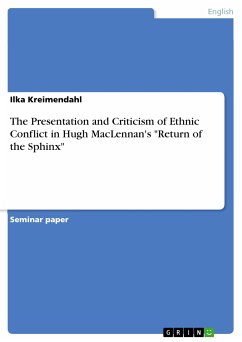Seminar paper from the year 2001 in the subject American Studies - Literature, grade: 2 (B), University of Kassel (Anglistics), course: Social Criticism in American and Candian Literature, language: English, abstract: The novel Return of the Sphinx, written by Hugh MacLennan in 1967, is not a sociopolitical study of English-French Canadian relations in Quebec, as many critics concluded. It rather deals with a series of interrelated conflicts, predominantly father against son, generation against generation and Quebec against Canada. However, the novel offers an extensive insight into the political and ethnic situation in Canada during the radical sixties, which remains a problematic one until today. This paper will examine the historical development of Canada's political instability, the origins of the ethnic conflict within the nation and, in addition, the continuing problems between the Québecois and the anglophone majority of the nation. In this context I will briefly talk about French-Canadian nationalism, the so-called 'Quiet Revolution', and the radicalism of the 1960s. In the second part the paper will work on the presentation and criticism of the ethnic conflict in Return of the Sphinx. The focal point here will be on the protagonist and his battle for a unified Canada, as well as on the antagonist and Quebec separatism. Furthermore, this composition will concentrate on the Greek tragedy of Oedipus Rex along with the symbolic use of the mythological figure of the sphinx1 and its association with the state of affairs in contemporary Canada. To conclude, I will summarize the results that follow from this work. 1 Sphinx in Greek mythology: daughter of Tyohon and the snake Echidna, a monster with the head and the breast of a woman and the winged body of a lion.
Dieser Download kann aus rechtlichen Gründen nur mit Rechnungsadresse in A, B, BG, CY, CZ, D, DK, EW, E, FIN, F, GR, HR, H, IRL, I, LT, L, LR, M, NL, PL, P, R, S, SLO, SK ausgeliefert werden.









